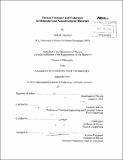Exciton transport and coherence in molecular and nanostructured materials
Author(s)
Akselrod, Gleb M. (Gleb Markovitch)
DownloadFull printable version (25.54Mb)
Alternative title
Mediating light and matter : excitons in organic and nanostructured materials.
Other Contributors
Massachusetts Institute of Technology. Department of Physics.
Advisor
Vladimir Bulović and Erich Ippen.
Terms of use
Metadata
Show full item recordAbstract
Over the past 20 years a new classes of optically active materials have been developed that are composites of nano-engineered constituents such as molecules, polymers, and nanocrystals. These disordered materials have enabled devices such as organic light emitting diodes, color tunable lasers, and low-cost photovoltaics, and hold promise as a platform for all-optical computing. The defining optical and electronic characteristic of molecular and nanostructured materials is the exciton, a bound electron hole pair. Excitons, which can be generated optically or electrically, are the nanoscale carriers of energy, acting as intermediates between photons and electronic excitations. The goal of this thesis is to add to the present understanding of two fundamental aspects of excitons in molecular and nanostructured materials. First we focus on the spatial transport of excitons, which is central to the operation of photovoltaics, LEDs, and potential excitonic transistors. Despite its importance, the precise dynamics of exciton transport and how it relates to disorder, the defining characteristic of molecular and nanostructured materials, remains elusive. Here we develop a technique for direct visualization of exciton transport. We reveal unambiguously that transport occurs by random walk diffusion and that it transitions to sub diffusive as energetic disorder is increased. Furthermore, we harness exciton transport in J-aggregate materials to build a platform for the enhancement of absorption and fluorescence of organic molecules and quantum dots. Second we turn to the interaction of excitons with optical microcavities. Using the thermally stable excitons in molecular materials, it is possible to create strongly coupled states of excitons and photons, known as polaritons. A longstanding research goal has been creating polaritons at high densities in order to study condensation phenomena and as a route to low threshold organic lasers. In this thesis we elucidate that a key mechanism that prevents polariton condensation is exciton-exciton annihilation. In order to circumvent annihilation, we develop a new microcavity architecture with an intracavity excitation scheme and demonstrate room temperature lasing through a polariton mode. Finally, we show super radiant lasing from an organic microcavity, an alternative method over strong coupling that results in a substantially reduced lasing threshold.
Description
Thesis (Ph. D.)--Massachusetts Institute of Technology, Dept. of Physics, 2013. Title as it appears in MIT degrees awarded booklet, September 2013: Mediating light and matter: excitons in organic and nanostructured materials. Vita. Cataloged from PDF version of thesis. Includes bibliographical references (pages [151]-165).
Date issued
2013Department
Massachusetts Institute of Technology. Department of PhysicsPublisher
Massachusetts Institute of Technology
Keywords
Physics.